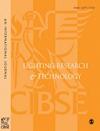编辑:下一代照明计算
IF 2.2
3区 工程技术
Q2 CONSTRUCTION & BUILDING TECHNOLOGY
引用次数: 0
摘要
100年前,Gibson和Tyndall正式提出了一个值,一年后,这个值被标准化为光视觉的CIE光谱发光效率函数V(λ)。20世纪20年代出现了几种新型计算机,但在20世纪40年代首次引入现代电子计算机之前。涉及新生流明的计算可能是手工完成的,当时处于照明科学的前沿。到20世纪60年代,有了计算平均水平照度的方法,如分区空腔法,并成为科学研究的主题,以了解误差水平并将适用性扩展到新的情况。随着20世纪80年代和90年代个人电脑的日益普及,基于光线追踪模型、辐射模型或两者组合的新型照明软件被引入,以减轻计算照明量的负担,将计算能力扩展到更广泛的应用程序,并提供渲染图像。照明计算软件的性能一直在不断提高,在过去的几年里,它已经开始包括更好的光谱量建模。照明计算的速度、准确性和实用性仍有提高的空间,本期的五篇文章都涉及到这方面的照明研究。Yoshizawa等人提出了一种用于空间照明计算和可视化的新模型——光子流(Photon Flow),它关注于光场本身,而不是表面约束的量。Chen等人提出了灰度亮度函数来确定平均亮度和空间亮度系数。Tsesmelis等人提出了一种神经网络架构DeepLux,用于实时预测室内场景的照度。最后两篇文章的重点是频谱功率分布(spd)。Lokesh等人的工作也应用了神经网络,但它们的用途是预测spd随时间的变化。最后,Royer等人记录了一种用于计算彩色混合LED系统的大型元集的新算法。在接下来的几年里,关注这些方法以及其他肯定会遵循的方法将如何影响照明实践和照明结果将是一件有趣的事情。人工智能、机器学习和数据科学已经成为许多科学领域的关键要素,但照明行业——这个并不以快速变化而闻名的行业——可能不得不从自身之外寻找有效整合新指标、方法、工作流程和商业模式的方法。正如Leland Curtis在本期的观点中所指出的那样,未来的照明实践可能会与今天的照明实践大不相同,人们将专注于提供可扩展的数字技术产品,而不是项目。我想知道Gibson和Tyndall,或者任何其他研究人员,他们的数据对流明的定义做出了贡献,他们是否设想过这样一个未来:计算软件可以提供实时、准确、逼真的空间光线渲染,以及相关的照明设计实践、照明质量、能源效率的改进——基本上是照明行业的所有方面。同样,从我们目前的观点来看,很难想象今天的研究如何能进一步改善下个世纪的建筑环境。近期的进展可能看起来很慢,但我相信,在这十年中所做的工作,以及在这个问题上所强调的,可能有一天会被视为新一代照明工具出现的转折点。本文章由计算机程序翻译,如有差异,请以英文原文为准。
Editorial: The next generation of lighting calculations
It’s been 100 years since Gibson and Tyndall formally proposed the values that were standardized a year later as the CIE spectral luminous efficiency function for photopic vision, V(λ). The 1920s was a decade when several new computing machines were introduced, but before the first introduction of modern electronic computers in the 1940s. Calculations involving the nascent lumen were likely done by hand and were then at the forefront of lighting science. By the 1960s, methods to calculate average horizontal illuminance, such as the zonal cavity method, were available and the subject of scientific research to understand error levels and extend applicability to new situations. With the increasing availability of personal computers in the 1980s and 1990s, new lighting software based on ray tracing models, radiosity models or a combination was introduced to ease the burden of computing lighting quantities, extend computational capabilities to a much wider range of applications and offer rendered images. The performance of lighting calculation software has continued to improve, and in the last several years, it has begun to include better modelling of spectral quantities as well. There’s still room to improve the speed, accuracy and utility of lighting calculations, and the five articles in this issue all relate to this aspect of lighting research. Yoshizawa et al. present a new model for spatial lighting calculations and visualizations, Photon Flow, which focuses on the light field itself rather than surface-bound quantities. Chen et al. propose a grayscale luminance function to determine average luminance and the spatial luminance coefficient. Tsesmelis et al. propose a neural network architecture, DeepLux, for predicting illuminance of indoor scenes in real time. The final two articles focus on spectral power distributions (SPDs). Lokesh et al. present work that also applies neural networks, but their use is to predict changes to SPDs over time. Finally, Royer et al. document a new algorithm for computing large sets of metamers for colour-mixed LED systems. In the coming years, it will be interesting to follow how these methods, and others that are sure to follow, will influence lighting practice and lighting outcomes. Artificial intelligence, machine learning and data science have become key elements of many scientific fields, but the lighting profession – which is not known for rapid change – may have to look outside itself to effectively integrate new metrics, methods, workflows and business models. As Leland Curtis suggests in this issue’s opinion, the future of lighting practice may be very different than what is common today, with a focus on delivering scalable digital technology products instead of projects. I wonder if Gibson and Tyndall, or any of the other researchers whose data contributed to the definition of the lumen, envisioned a future where calculation software could provide realtime, accurate, photorealistic rendering of light in a space, and the associated improvements to lighting design practice, lighting quality, energy efficiency – essentially all aspects of the lighting profession. Likewise, from our current viewpoint, it is difficult to imagine how the research of today can further improve the built environment in the next century. Near-term progress may seem slow, but I believe that the work being done in this decade, and highlighted in this issue, may one day be seen as a turning point from which a new generation of lighting tools emerged.
求助全文
通过发布文献求助,成功后即可免费获取论文全文。
去求助
来源期刊

Lighting Research & Technology
工程技术-光学
CiteScore
5.40
自引率
16.00%
发文量
69
审稿时长
>12 weeks
期刊介绍:
Lighting Research & Technology (LR&T) publishes original peer-reviewed research on all aspects of light and lighting and is published in association with The Society of Light and Lighting. LR&T covers the human response to light, the science of light generation, light control and measurement plus lighting design for both interior and exterior environments, as well as daylighting, energy efficiency and sustainability
 求助内容:
求助内容: 应助结果提醒方式:
应助结果提醒方式:


